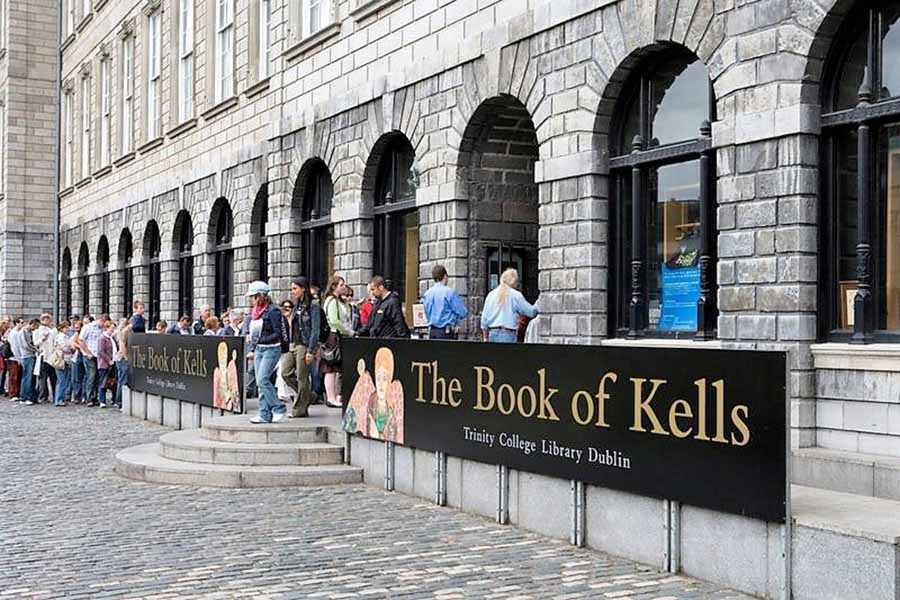
The Book of Kells Experience at Trinity College Dublin, located in the heart of Dublin city on College Green, is one of Ireland’s premier cultural attractions, drawing around onem visitors annually. Housed in the Old Library of Ireland’s oldest university (founded 1592), the Book of Kells is a 9th-century illuminated manuscript of the four Gospels in Latin, renowned for its intricate artistry and UNESCO Memory of the World status. Described by the 11th-century Annals of Ulster as “the most precious object in the Western world,” it’s a must-see for history, art, and culture enthusiasts.
A visit to the Book of Kells Experience typically lasts 1–2 hours and includes access to the Old Library, the Book of Kells exhibition, and a new digital immersive component in the Red Pavilion. The experience is open year-round, except December 24–26, with hours varying by season: Monday–Saturday 8:30 AM–6:30 PM and Sunday 9:30 AM–5:00 PM (April–September); Monday–Saturday 9:30 AM–5:00 PM and Sunday 12:00 PM–4:30 PM (October–March). Here’s a breakdown of the core experience:
The Book of Kells Exhibition (Chapter 1: Old Library):
- The Treasury: Visitors view the Book of Kells, a 1,200-year-old manuscript created by Celtic monks, likely on Iona, Scotland, and completed at Kells, County Meath, around 800 AD. Made from high-quality calf vellum with 680 pages, it features vibrant illustrations of mythical creatures, animals, Christian iconography, and Celtic knotwork. Two volumes are displayed under strict security: one open to a major decorated page and another to text pages with smaller decorations. Photography is prohibited in the Treasury to protect the manuscript.
- Turning Darkness into Light Exhibition: Before entering the Treasury, an informative display explores the manuscript’s history, artistry, and monastic context, including the pigments used (e.g., orpiment for yellow, red lead, copper green). Recent research confirms no lapis lazuli was used, contrary to prior assumptions. The exhibit is essential for understanding the book’s cultural and religious significance.
- The Long Room: After the Treasury, visitors enter the 65-meter-long, 300-year-old Long Room, one of the world’s most beautiful libraries. Normally housing 200,000 of Trinity’s oldest books, it’s currently undergoing a major restoration, with most books removed. Visitors can still admire its elegant wooden structure, marble busts of figures like Jonathan Swift and Samuel Beckett, and exhibits like the Brian Boru Harp (Ireland’s oldest surviving harp, 15th century, and a national symbol) and a rare 1916 Proclamation of the Irish Republic. The atmosphere, with its historic scent of dust and old books, is often described as “Harry Potter-esque.”
- Gaia Installation: Luke Jerram’s illuminated artwork, featuring NASA imagery of Earth in three dimensions, is displayed in the Long Room, adding a modern, awe-inspiring element to the historic setting.
Chapter 2: Red Pavilion
- Immersive Digital Exhibition: Located next to the Old Library, the Red Pavilion hosts a cutting-edge digital experience, Book of Kells 360, launched in recent years. This immersive journey uses light, sound, animations, and projections to bring the manuscript’s history and artistry to life. Visitors interact with digital sculptures of figures like Ada Lovelace, Jonathan Swift, and Rosalind Franklin, and explore the Library’s collections through a high-tech narrative.
- High-resolution digital images of the Book of Kells, rescanned from 1990 transparencies, offer a detailed view second only to seeing the manuscript in person. These are also available online via Trinity’s Digital Collections.
- Trinity Trails Guided Tour (Optional Add-On): A 45-minute guided walking tour of Trinity’s 47-acre campus, led by expert student or alumni guides, can be added for €6–€10. Highlights include the Campanile (avoid walking under it during bell tolls to dodge the student superstition of failing exams), the monumental archways, and historic squares. The tour covers Trinity’s history, from its 1592 founding by England’s Queen Elizabeth I to its notable alumni (Oscar Wilde, Samuel Beckett, Bram Stoker). Rated five stars by visitors, it’s a lively way to contextualize the campus.
- Self-guided tours are available via the free Visit Trinity app, offering virtual tours and audio guides with insights from Trinity experts.
Practical Details:
- Trinity College Dublin, College Green, Dublin 2, opposite the former Irish Houses of Parliament (now Bank of Ireland). It’s a 3-minute walk from Nassau Saint bus stops (routes 11, 37, 38, 39, 40, 70, 180), 4 minutes from Trinity Luas Green Line stop, or 10 minutes from Pearse Street DART station. No public parking is available on campus; nearby options include Q-Park Setanta Place or Fleet Street.
- Admission: Standard adult tickets cost €25 (online, €26 at the gate); concessions for seniors/students (€20–€22); family tickets (2 adults + 2 children) €60. Trinity students, staff, and alumni get free entry with up to 2 guests (pre-booking required via bookofkellsexperience@tcd.ie). Children under 6 are free. Tickets include the Old Library, Book of Kells, Gaia, and Red Pavilion’s digital exhibition. The Dublin Pass offers free entry. Online booking at www.visittrinity.ie is strongly recommended to avoid long queues, especially in summer.
- The Old Library and Red Pavilion are wheelchair-accessible, with lifts and ramps. Sensory backpacks are available (free, subject to availability) for visitors with sensory needs. Audio guides and the Visit Trinity app enhance accessibility. The Long Room’s upper level is inaccessible to wheelchair users.
- Facilities: The Library Shop sells unique gifts, including the 2025 Trinity Diary and collaborations with Avoca Handweavers and Newbridge Silverware. No cloakroom is available, so avoid large bags. Nearby dining includes The Buttery (university canteen), Perch Café, and Pavilion Bar (popular with students). Non-flash photography is allowed in the Long Room and campus but not in the Treasury.
Cultural and Historical Significance:
- The Book of Kells was created in Kells in county Meath although online sources sorties reiterate the 1880s claim by some some London academics that it came from Scotland’s Iona. It survived turmoil, including the three sided wars of the 1640s, before arriving at Trinity in the 1650s via Charles Lambert, Earl of Cavan. It’s been displayed since the mid-1800s.
- The Long Room, built 1712–1732, is part of Trinity’s library, a legal deposit for every book published in Ireland and England, housing over 4.5m items. The manuscript’s vibrant pigments and intricate designs have inspired modern Irish art, jewelry, and textiles.
Visitor Tips:
- Timing: Arrive early (8:30 AM April–September, 9:30 AM October–March) or book late afternoon slots to avoid crowds. Summer (June–August) is busiest; March or October offers a quieter experience.
- Weather: Dublin’s rain makes the indoor exhibition ideal for wet days. Bring a light jacket for outdoor campus walks.
- Combine with Nearby Sites: Visit the National Gallery of Ireland (5-minute walk), Dublin Castle (10 minutes), or Saint Stephen’s Green (8 minutes). Grafton Street’s shops and buskers are nearby.
- Crowd Management: Some visitors find the Treasury crowded and the manuscript underwhelming due to seeing only two pages. The exhibition and Long Room enhance the experience, but manage expectations for the book itself.
What’s New for 2025
- The Book of Kells Experience is evolving amid the ongoing Old Library Redevelopment Project, a major restoration to preserve the 18th-century building and its collections. Here are the key updates for 2025:
- A €90m restoration, funded partly by €17m in annual ticket revenue, is underway to protect the Long Room from humidity, dust, and the impact of onem visitors yearly. By 2025, 200,000 books have been removed from the Long Room’s shelves for conservation, a process visitors can witness as a “once-in-a-lifetime” event. Digital projections reimagine the Long Room’s historic appearance, maintaining its grandeur despite empty shelves. The project will close the Long Room entirely by the end of 2025, making 2025 the last chance to see it for several years.
- The Book of Kells and Gaia remain on display, and the Red Pavilion’s digital exhibition ensures a full experience despite the restoration.
- The Book of Kells 360 in the Red Pavilion, introduced in recent years, continues to expand with new interactive elements in 2025. High-resolution scans of the manuscript, updated from 1990 transparencies, offer unprecedented detail, complementing the physical viewing. The digital exhibition includes animations and sculptures of historical figures, enhancing engagement for all ages.
- Luke Jerram’s Gaia, a 3D illuminated Earth using NASA imagery, remains a highlight in the Long Room for 2025, adding a contemporary contrast to the historic setting. Its presence underscores Trinity’s blend of tradition and innovation.
- The 45-minute guided tours now include updated narratives about Trinity’s role in modern Irish history, such as discussions post-1916 Easter Rising, reflecting the campus’s evolving inclusivity since the Catholic Church relaxed restrictions in 1970. The Visit Trinity app has been updated with new audio content for 2025, offering deeper insights into the Book of Kells and campus landmarks.
Protest Impact Resolved:
- In 2024, student protests over Trinity’s ties to Israel temporarily closed the Old Library and Book of Kells Experience, causing financial losses (€350,000 weekly). By 2025, access is fully restored, ensuring uninterrupted visits. Online booking remains critical to manage high demand.
Tips for Visitors
- Book Early: Reserve timed-entry tickets at www.visittrinity.ie to avoid long queues, especially in summer. Trinity students/staff/alumni can book free tickets (with 2 guests) via bookofkellsexperience@tcd.ie, at least 3 days in advance.
- Go Early: Arrive at opening (8:30 AM April–September, 9:30 AM October–March) for a quieter experience, especially in the Treasury.
- Maximize the Experience: Add the Trinity Trails tour (€29 adult with Book of Kells) for campus context. Download the Visit Trinity app for free audio guides.
- Expect Restoration Impacts: The Long Room’s empty shelves are part of the 2025 experience, enhanced by digital projections. Visit before the end-of-2025 closure for the full effect.
- Budget Wisely: Pack snacks to save on café costs. The Library Shop offers unique gifts but can be pricey.
- Request sensory backpacks at the welcome desk for neurodiverse visitors. Wheelchair users should note the Long Room’s upper level is inaccessible.
- Nearby Attractions: Combine with the National Gallery of Ireland, Dublin Castle, or EPIC The Irish Emigration Museum (all within 10–15 minutes’ walk).







